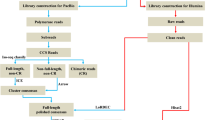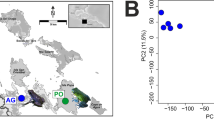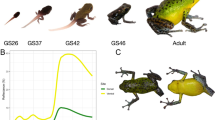Abstract
Across diverse taxa, an increasing number of photoreceptive systems are being discovered in tissues outside of the eye, such as in the skin. Dermal photoreception is believed to serve a variety of functions, including rapid color change via specialized cells called chromatophores. In vitro studies of this system among color-changing fish have suggested the use of a phototransduction signaling cascade that fundamentally differs from that of the retina. Thus, the goal of this study was to identify phototransduction genes and compare their expression in the retina and skin of a color-changing fish, the hogfish Lachnolaimus maximus. De novo transcriptomics revealed the expression of genes that may underlie distinct, yet complete phototransduction cascades in L. maximus retina and skin. In contrast to the five visual opsin genes and cGMP-dependent phototransduction components expressed in the retina of L. maximus, only a single short-wavelength sensitive opsin (SWS1) and putative cAMP-dependent phototransduction components were expressed in the skin. These data suggest a separate evolutionary history of phototransduction in the retina and skin of certain vertebrates and, for the first time, indicate an expression repertoire of genes that underlie a non-retinal phototransduction pathway in the skin of a color-changing fish.


Similar content being viewed by others
Abbreviations
- CNS:
-
Central nervous system
- COGs:
-
Cluster of orthologous groups of proteins
- GO:
-
Gene ontology
- GPCR:
-
G-protein-coupled receptor
- ORF:
-
Open-reading frame
- PDE:
-
Phosphodiesterase
- TPM:
-
Transcripts per million reads
References
Andrews S (2010) FastQC: a quality control tool for high throughput sequence data. http://www.bioinformatics.babraham.ac.uk/projects/fastqc/. Accessed 1 June 2017
Arshavsky VY, Lamb TD, Pugh EN (2002) G proteins and phototransduction. Ann Rev Physiol 64:153–187
Bagnara JT, Hadley ME (1973) Chromatophores and color change. Prentice Hall, New Jersey
Bagnara JT, Taylor JD, Hadley ME (1968) The dermal chromatophore unit. J Cell Biol 38:67–79
Ban E, Kasai A, Sato M, Yokozeki A, Hisatomi O, Oshima N (2005) The signaling pathway in photoresponses that may be mediated by visual pigments in erythrophores of Nile tilapia. Pigm Cell Melanoma R 18:360–369
Bolger AM, Lohse M, Usadel B (2014) Trimmomatic: a flexible trimmer for Illumina sequence data. Bioinformatics 30:2114–2120
Chen SC, Robertson RM, Hawryshyn CW (2013) Possible involvement of cone opsins in distinct photoresponses of intrinsically photosensitive dermal chromatophores in tilapia Oreochromis niloticus. PLoS One 8:e70342
Chen SC, Xiao C, Troje NF, Robertson RM, Hawryshyn CW (2015) Functional characterisation of the chromatically antagonistic photosensitive mechanism of erythrophores in the tilapia Oreochromis niloticus. J Exp Biol 218:748–756
Clothier J, Lythgoe JN (1987) Light-induced colour changes by the iridophores of the Neon tetra, Paracheirodon innesi. J Cell Sci 88:663–668
Conesa A, Götz S, García-Gómez JM, Terol J, Talón M, Robles M (2005) Blast2GO: a universal tool for annotation, visualization and analysis in functional genomics research. Bioinformatics 21:3674–3676
Cooper DM, Mons N, Karpen J (1995) Adenylyl cyclases and the interaction between calcium and cAMP signalling. Nature 374:421–424
Daniolos A, Lerner A, Lerner M (1990) Action of light on frog pigment cells in culture. Pigm Cell Melanoma R 3:38–43
Florey E (1966) Nervous control and spontaneous activity of the chromatophores of a cephalopod, Loligo opalescens. Comp Biochem Physiol 18:305–324
Fujii R (1993) Cytophysiology of fish chromatophores. Int Rev Cytol 143:191–255
Fujii R (2000) The regulation of motile activity in fish chromatophores. Pigm Cell Res 13:300–319
Fujii R, Oshima N (1986) Control of chromatophore movements in teleost fishes. Zool Sci 3:13–47
Fulgione D, Trapanese M, Maselli V, Rippa D, Itri F, Avallone B, Van Damme R, Monti DM, Raia P (2014) Seeing through the skin: dermal light sensitivity provides cryptism in Moorish gecko. J Zool 294:122–128
Grabherr MG, Haas BJ, Yassour M, Levin JZ, Thompson DA, Amit I, Adiconis X, Raychowdhury R, Zeng Q, Chen Z, Mauceli E, Hacohen N, Gnirke A, Rhind N, di Palma F, Birren B, Nusbaum C, Lindblad-Toh K, Friedman N, Regev A (2011) Trinity: reconstructing a full-length transcriptome without a genome from RNA-Seq data. Nature Biotechnol 29:644–652
Haas BJ, Papanicolaou A, Yassour M, Grabherr M, Blood PD, Bowden J, Couger M, Eccles D, Li B, Lieber M, MacManes M, William T, Dewey C, Henscel R, LeDur R, Friedman N, Regev A (2013) De novo transcript sequence reconstruction from RNA-Seq: reference generation and analysis with Trinity. Nat Protoc 8:1494–1512
Hanlon R (2007) Cephalopod dynamic camouflage. Curr Biol 17:R400-R404
Hara T, Hara R (1976) Distribution of rhodopsin and retinochrome in the squid retina. J Gen Physiol 67:791–805
Hara T, Hara R, Takeuchi J (1967) Vision in octopus and squid: rhodopsin and retinochrome in the octopus retina. Nature 214:572–573
Hartwig HG, Oksche A (1982) Neurobiological aspects of extraretinal photoreceptive systems: structure and function. Experientia 38:991–996
Jones P, Binns D, Chang HY, Fraser M, Li W, McAnulla C, McWilliam H, Maslen J, Mitchell A, Nuka G, Pesseat S, Quinn A, Sangrador-Vegas A, Scheremetjew M, Yong SY, Lopez R, Hunter S (2014) InterProScan 5: genome-scale protein function classification. Bioinformatics 30:1236–1240
Kanaho Y, Tsai SC, Adamik R, Hewlett EL, Moss J, Vaughan M (1984) Rhodopsin-enhanced GTPase activity of the inhibitory GTP-binding protein of adenylate cyclase. J Biol Chem 259:7378–7381
Kasai A, Oshima N (2006) Light-sensitive motile iridophores and visual pigments in the neon tetra, Paracheirodon innesi. Zool Sci 23:815–819
Kelley JL, Davies WI (2016) The biological mechanisms and behavioral functions of opsin-based light detection by the skin. Front Ecol Evol 4:106
Kingston AC, Cronin TW (2016) Diverse distributions of extraocular opsins in crustaceans, cephalopods, and fish. Integr Comp Biol 56:820–833
Kingston AC, Kuzirian AM, Hanlon RT, Cronin TW (2015) Visual phototransduction components in cephalopod chromatophores suggest dermal photoreception. J Exp Biol 218:1596–1602
Kojima D, Fukada Y (1999) Non-visual photoreception by a variety of vertebrate opsins. In: Rhodopsins and phototransduction, vol 224. Wiley, Chichester, pp 265–282
Langmead B, Salzberg SL (2012) Fast gapped-read alignment with Bowtie 2. Nat Methods 9:357–359
Lees AD (1948) The sensory physiology of the sheep tick, Ixodes ricinus L.. J Exp Biol 25:145–207
Li B, Dewey CN (2011) RSEM: accurate transcript quantification from RNA-Seq data with or without a reference genome. BMC Bioinf 12:323
Marra NJ, Richards VP, Early A, Bogdanowicz SM, Bitar PP, Stanhope MJ, Shivji MS (2017) Comparative transcriptomics of elasmobranchs and teleosts highlight important processes in adaptive immunity and regional endothermy. BMC Genom 18:87
Mäthger LM, Roberts SB, Hanlon RT (2010) Evidence for distributed light sensing in the skin of cuttlefish, Sepia officinalis. Biol Lett 6:600–603
McBride RS, Johnson MR (2007) Sexual development and reproductive seasonality of hogfish (Labridae: Lachnolaimus maximus), a hermaphroditic reef fish. J Fish Biol 71:1270–1292
McBride RS, Murphy MD (2003) Current and potential yield per recruit of hogfish, Lachnolaimus maximus, in Florida. Proc Gulf Caribb Fish Inst 54:513–525
McClanahan TR (1999) Predation and the control of the sea urchin Echinometra viridis and fleshy algae in the patch reefs of Glovers Reef. Belize Ecosyst 2:511–523
Messenger JB (2001) Cephalopod chromatophores: neurobiology and natural history. Biol Rev 76:473–528
Miyashita Y, Moriya T, Yokosawa N, Hatta S, Arai JI, Kusunoki S, Toratani S, Yokosawa H, Fujii N, Asami K (1996) Light-sensitive response in melanophores of Xenopus laevis: II. Rho is involved in light-induced melanin aggregation. J Exp Zool Part A 276:125–131
Moutsaki P, Whitmore D, Bellingham J, Sakamoto K, David-Gray ZK, Foster RG (2003) Teleost multiple tissue (tmt) opsin: a candidate photopigment regulating the peripheral clocks of zebrafish? Mol Brain Res 112:135–145
Negishi S (1985) Light response of cultured melanophores of a teleost adult fish, Oryzias latipes. J Exp Zool Part A 236:327–333
Nery LM, de Lauro Castrucci AM (1997) Pigment cell signalling for physiological color change. Comp Biochem Phys A 118:1135–1144
Nilsson Sköld H, Aspengren S, Wallin M (2013) Rapid color change in fish and amphibians–function, regulation, and emerging applications. Pigm Cell Melanoma R 26:29–38
Oshima N (2001) Direction reception of light by chromatophores of lower vertebrates. Pigm Cell Melanoma R 14:312–319
Page TL (1982) Extraretinal photoreception in entrainment and photoperiodism in invertebrates. Cell Mol Life Sci 38:1007–1013
Parra G, Bradnam K, Korf I (2007) CEGMA: a pipeline to accurately annotate core genes in eukaryotic genomes. Bioinformatics 23:1061–1067
Porter ML, Blasic JR, Bok MJ, Cameron EG, Pringle T, Cronin TW, Robinson PR (2011) Shedding new light on opsin evolution. Proc R Soc B rspb.2011.1819
Provencio I, Jiang G, Willem J, Hayes WP, Rollag MD (1998) Melanopsin: An opsin in melanophores, brain, and eye. Proc Natl Acad Sci 95:340–345
Ramachandran VS, Tyler CW, Gregory RL, Rogers-Ramachandran D, Duensing S, Pillsbury C, Ramachandran C (1996) Rapid adaptive camouflage in tropical flounders. Nature 379:815–818
Ramirez MD, Oakley TH (2015) Eye-independent, light-activated chromatophore expansion (LACE) and expression of phototransduction genes in the skin of Octopus bimaculoides. J Exp Biol 218:1513–1520
Ramirez MD, Speiser DI, Pankey MS, Oakley TH (2011) Understanding the dermal light sense in the context of integrative photoreceptor cell biology. Vis Neurosci 28:265–279
Rayer B, Naynert M, Stieve H (1990) New trends in photobiology: phototransduction: different mechanisms in vertebrates and invertebrates. J Photochem Photobiol B 7:107–148
Rodieck RW (1973) The vertebrate retina: principles of structure and function. Freeman, San Francisco
Rollag MD, Berson DM, Provencio I (2003) Melanopsin, ganglion-cell photoreceptors, and mammalian photoentrainment. J Biol Rhythms 18:227–234
Sato M, Yokozeki A, Oshima N (2000) Signal transduction in direct effects of light on tilapia erythrophores. Zool Sci 17:111
Seyoum S, Collins AB, Puchulutegui C, McBride RS, Tringali MD (2015) Genetically determined population structure of hogfish (Labridae: Lachnolaimus maximus) in the southeastern United States. Fish B NOAA 113:442–455
Shao C, Bao B, Xie Z, Chen X, Li B, Jia X, Yao Q, Orti G, Wenhui L, Li X, Hamre K, Xu J, Wang L, Chen F, Tian Y, Schreiber A, Wang H, Wei F, Zhang J, Dong Z, Gao L, Gai J, Sakamoto T, Mo S, Chen W, Hamre K (2017) The genome and transcriptome of Japanese flounder provide insights into flatfish asymmetry. Nat Genet 49:119–124
Steven DM (1963) The dermal light sense. Biol Rev 38:204–240
Sumner FB (1911) The adjustment of flatfishes to various backgrounds: a study of adaptive color change. J Exp Zool Part A 10:409–506
Tong D, Rozas NS, Oakley TH, Mitchell J, Colley NJ, McFall-Ngai MJ (2009) Evidence for light perception in a bioluminescent organ. Proc Natl Acad Sci 106:9836–9841
Townsend CH (1929) Records of changes in color among fishes. Zoologica 9:321:378
Weber W (1983) Photosensitivity of chromatophores. Am Zool 23:495–506
Wigglesworth VB (1950) Principles of insect physiology. London, New York
Yamashita T, Ohuchi H, Tomonari S, Ikeda K, Sakai K, Shichida Y (2010) Opn5 is a UV-sensitive bistable pigment that couples with Gi subtype of G protein. Proc Natl Acad Sci 07:22084–22089
Yarfitz S, Hurley JB (1994) Transduction mechanisms of vertebrate and invertebrate photoreceptors. J Biol Chem 269:14329–14329
Yokoyama S (2002) Molecular evolution of color vision in vertebrates. Gene 300:69–78
Acknowledgements
We would like to acknowledge Duke University’s Shared Cluster Resource and Duke Biology’s Charles W. Hargitt Research Fellowship, which were essential to the success of the presented work. We also thank Dr. Nicholas Marra and his colleagues for sharing their Lachnolaimus maximus cardiac transcriptome, as well as Dean Kimberly for consenting the use of his photography in our paper. Finally, we thank Benjamin R. Wheeler for his insight and logistical support that contributed to the success of this project, and Dr. Daniel Speiser, Katie Thomas, and Eleanor Caves for their insight and comments on the earlier versions of the manuscript.
Funding
This study was funded by Charles W. Hargitt Fellowship provided by Duke University.
Author information
Authors and Affiliations
Corresponding author
Ethics declarations
Conflict of interest
The authors declare that they have no conflict of interest.
Ethical approval
All applicable international, national, and/or institutional guidelines for the care and use of animals were followed. All procedures performed in studies involving animals were in accordance with the ethical standards of Duke University’s Institutional Animal Care and Use Committee (protocol registry number A233-16-10).
Electronic supplementary material
Below is the link to the electronic supplementary material.
Supplemental Fig. 1
Top blast-hit abundance by species yielded from BLASTx analyses of the Lachnolaimus maximus transcriptome (PDF 129 KB)
Supplemental Fig. 2
Tissue-level comparison of Lachnolaimus maximus transcriptome annotation. Venn diagrams indicate the number of unique genes and unique gene ontology (GO) terms assigned to retinal and skin tissues (a). GO term distribution for the Biological Processes category (level 2) is compared for both tissues (b) (PDF 98 KB)
Supplemental Fig. 3
Tissue-level comparison of Lachnolaimus maximus GO term transcriptome annotation. Second level GO term distribution for the Molecular Function category (a) and Cellular Component category (b) are shown (PDF 91 KB)
Supplemental Table 1
Comprehensive information table of every contig from the assembly of the hogfish (Lachnolaimus maximus) transcriptome. Mapping statistics are given for contigs combined from the retina and skin (i.e., “All”) as well as for each individual tissue: TPM = transcripts per million mapped reads, FPKM = fragments per kilobase transcript length per million fragments mapped, IsoPct = percent expression of an isoform for a given gene, ORF = open-reading frame (CSV 117609 KB)
Rights and permissions
About this article
Cite this article
Schweikert, L.E., Fitak, R.R. & Johnsen, S. De novo transcriptomics reveal distinct phototransduction signaling components in the retina and skin of a color-changing vertebrate, the hogfish (Lachnolaimus maximus). J Comp Physiol A 204, 475–485 (2018). https://doi.org/10.1007/s00359-018-1254-4
Received:
Revised:
Accepted:
Published:
Issue Date:
DOI: https://doi.org/10.1007/s00359-018-1254-4




